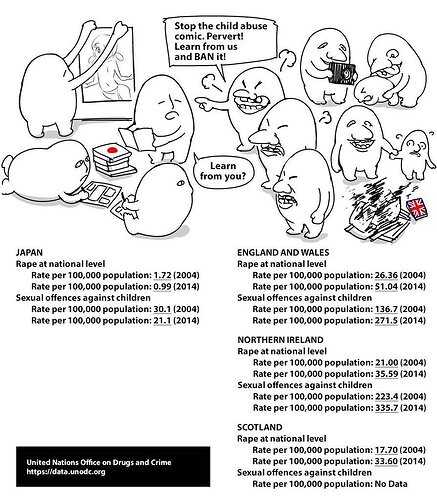"
The highly gendered nature of sex dolls and robots is rarely acknowledged by academic supporters of the products. The vast majority of these dolls and robots are embodied female, typically designed according to pornographic standards. Research indicates that sex-doll owners are overwhelmingly men. Child sex dolls are similarly gendered and modelled on the bodies of prepubescent girls. I am yet to see a male-bodied child doll. Essentially, these products are lifelike material representations of women and girls marketed for men’s sexual use.
Academic proponents of female-bodied sex dolls and robots fail to situate the products within the wider cultural context in which they are produced — one in which gender inequality persists, where male violence against women and children remains a serious global problem, and where women and girls are raped, beaten, abused and prostituted by men. Within an existing system of male dominance and female subordination, female-bodied sex dolls reinforce women’s subordinate status and the sexual objectification of women and girls. Despite this reality, a number of academics encourage the manufacture of these products for men’s sexual use, and some actually herald child sex dolls as a therapeutic treatment for child rapists — an approach that I see as both misguided and irresponsible."
Child-sex-doll advocates claim that childlike dolls will prevent the abuse of actual children. However, there is no assurance that paedophiles who have access to child dolls will use them instead of, and not in addition to, children. There is no evidence for the previously popular idea that men perpetrate sexual violence against women, children and other men due to uncontrollable sexual desire, or because they do not have a sufficient outlet for their urges. Likewise, there is no evidence that child sex dolls will lead to a reduction in the abuse of children.
There is no shortage of sexual outlets available to men outside of traditional intimate relationships. Men can pursue sexual encounters by means of dating or hook-up apps; they can access an endless supply of pornography, view webcam models or engage in cybersex. In many parts of the world there is a thriving legal sex industry where men can access a range of women for sex, and now there are sex-doll brothels. Nonetheless, having access to these outlets has not stopped men from raping. On the contrary, sexual violence remains prevalent across the world.
The argument that child sex dolls could function as a sexual outlet, preventing individuals who would otherwise rape children from doing so, also fails to consider the wider cultural context in which these products are manufactured — a system of institutionalised male dominance, routine sexual objectification of women and a culture that eroticises girls.
Cultural messaging increasingly presents girls as sexually available and appealing. The “Teen” porn genre consistently features on the online pornography aggregator Pornhub’s list of most popular search terms. “Barely Legal” pornography featuring teens with pigtails, flat chests and braces can be purchased in newsagents and petrol stations. G-strings, padded bras and bikini tops, and underwear with sexually suggestive slogans are marketed to pre-teen girls. Advertising material depicts girls in sexualised and adultified ways. Schoolgirls are fetishised, and sexy-schoolgirl costumes are sold in mainstream retailers. Instagram routinely hosts sexualised content of underage girls and comment responses from predatory men. Major bookstores and online marketplaces have been exposed selling erotic e-books that feature incest and child abuse. Adult retailers sell male masturbators designed to emulate the vaginas of teenage girls — such as the Teenage Dream or Lolita Vibrating Vagina — with promotional material emphasising youth and innocence.
Claims from child-sex-doll advocates that the dolls could prevent child sexual abuse — because paedophiles will use dolls instead of children — are speculative. In order to justify the development of child sex dolls and robots, supporters would have to establish that child sexual abuse is perpetrated by medically designated “paedophiles,” and that paedophiles will use dolls instead of children.
But it is not just paedophiles who perpetrate crimes of sexual violence against children. Not all child sex offenders are paedophiles, and not all paedophiles sexually offend against children. According to the Australian Institute of Criminology, while some perpetrators of child sexual abuse are attracted to children, they may also have a sexual interest in, or offend against, adults. Child sex offenders may also act out of opportunity rather than sexual attraction to children. Research by Richard Wortley and Stephen Smallbone finds that situational and environmental factors play an important role in sexual offences against children, and further research highlights the role of opportunity in child sexual abuse — including institutional and church settings, online child exploitation and child sex tourism.
If child sexual abuse is also perpetrated by individuals who are not primarily sexually attracted to children — men who do not have a pre-existing sexual preference for children — then claims that child sex dolls could protect children from abuse are questionable. How effective could child sex dolls for paedophilic use be in preventing child abuse if many offenders are not actually paedophiles?
Even if it could be determined that child sexual abuse was perpetrated solely by paedophiles with a sexual preference for children, in order to justify the manufacture of child sex dolls or robots it would have to be further established that providing them for paedophiles would prevent their offending against children. According to Marie-Helen Maras and Lauren Shapiro from City University of New York, therapeutic child sex dolls for paedophilic use are “nonsensical and irrational.” Childlike sex dolls normalise child abuse and domination rather than inhibiting it and go against cognitive-behavioural-therapy goals, which challenge undesirable thoughts and behaviour.
the dolls will prevent sexual offences against children, the opposite is the more likely outcome. Child sex dolls harm children through legitimising and normalising their sexual use. Instead of satisfying users’ sexual appetites for children, they could encourage and even strengthen these urges. Child sex dolls could have a “reinforcing effect” on paedophilic ideation, claims Peter Fagan from John Hopkins School of Medicine, and the use of such dolls could cause paedophilic urges to be acted on with more urgency.
Legislators and law-enforcement agencies believe that there could be a link between child sex dolls and sexual offending against children. A relationship between viewing child-exploitation material and contact offending has been established. There may also be a link between child-sex-doll ownership and possession of child-abuse material. In 2018, a police raid in Melbourne saw child sex dolls seized alongside “horrific” child-exploitation material, including videos of children and babies being tortured. In the United Kingdom, twenty out of twenty-six recent child-sex-doll offenders were found in possession of child-abuse material. Also in the United Kingdom, a surge in seizures of child sex dolls led police to identify previously unknown suspected paedophiles, resulting in seven men being charged, and six more facing allegations linked to child-exploitation images. According to the Crown Prosecution Services, child-sex-doll cases can be an indication of other offending against children.
A report from the Australian Institute of Criminology released last year argued that child sex dolls present a risk of escalation in sexual offences against children. Authors Rick Brown and Jane Shelling claimed that child sex dolls could “promote a continuum of behaviour that results in contact offending, by bridging the gap between fantasy and reality.” Patterns of escalation have already been documented in consumers of child-exploitation material, and researchers believe that consumers of child-abuse material could progress to using child dolls.
On a child-exploitation spectrum from viewing child exploitation to contact offending, performing sex acts on a childlike doll may be understood as a natural progression from viewing child-abuse material, and a step closer to sexually abusing a child. As Open University lecturer Litska Strikwerda acknowledges, using a child sex robot could be a much closer experience to actually sexually abusing a child. Maras and Shapiro argue that recent UK arrests for importing child sex dolls indicate that offenders escalate from viewing child-exploitation material to engaging in physical acts with child sex dolls:
In these cases, child pornography did “whet the appetite of the perpetrators” as their “thoughts” (fantasies about sex acts with children) became “behaviours” (through buying and importing the child sex doll to perform sex acts with it).
Child sex dolls could increase the likelihood of child abuse by reducing any barriers to committing sexual offences against children. Users could be desensitised to the harms of child sexual abuse, as dolls give no emotional feedback. Child sex dolls could also be used by sex offenders in the act of sexually assaulting a child. Child sex offenders could use childlike dolls as a tool to groom children for sexual abuse, just as predators have used pornography to groom children. Brown and Shelling note that sex dolls have been used to groom children for sexual abuse, and child sex dolls could arguably be even more effective for grooming children than adult sex dolls.
Would like to hear you guys thoughts on this, found it pretty biased. And while sure, the majority of sex dolls are female, as soon as they get less and less stigmatized there will be (possibly) more child sex dolls of boys and dolls for women.


